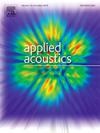Sound source localization in a natural soundscape with autonomous recorder units based on a new time-difference-of-arrival algorithm
IF 3.4
2区 物理与天体物理
Q1 ACOUSTICS
引用次数: 0
Abstract
Acoustic sound source localization is an emerging approach in animal behavior and ecology to either monitor individuals or to describe the spatial and temporal structure of natural soundscapes. The localization of sound sources mainly rely on the deployment in the field of microphone arrays and on the subsequent pairwise comparison of signals to infer position through triangulation. However, most of the current methods face the challenge of separating or not the sound sources before estimating their spatial position. On the one hand, source localization with upstream separation is particularly challenging in noisy outdoor environments. On the other hand, no-separation sound source localization can be possible only when calling rates are low. Here, using four outdoor low-cost recorders, we propose a new method which is an intermediate between the separation and no-separation strategies. Our deterministic algorithm combines a rough call separation, the computation and self-consistency check of time difference of arrivals, the separation or aggregation of sound sources, the localization of the sources in Cartesian or polar coordinates, and the final identification by an expert. We tested this method on a 190 min soundscape recording achieved in a temperate freshwater environment. The automated analysis revealed the space and time pattern of an amphibian, avian and human complex soundscape. This procedure opens the possibility to deploy similar passive acoustic programs to monitor either predetermined individuals or the composition of dynamic soundscapes.
求助全文
约1分钟内获得全文
求助全文
来源期刊

Applied Acoustics
物理-声学
CiteScore
7.40
自引率
11.80%
发文量
618
审稿时长
7.5 months
期刊介绍:
Since its launch in 1968, Applied Acoustics has been publishing high quality research papers providing state-of-the-art coverage of research findings for engineers and scientists involved in applications of acoustics in the widest sense.
Applied Acoustics looks not only at recent developments in the understanding of acoustics but also at ways of exploiting that understanding. The Journal aims to encourage the exchange of practical experience through publication and in so doing creates a fund of technological information that can be used for solving related problems. The presentation of information in graphical or tabular form is especially encouraged. If a report of a mathematical development is a necessary part of a paper it is important to ensure that it is there only as an integral part of a practical solution to a problem and is supported by data. Applied Acoustics encourages the exchange of practical experience in the following ways: • Complete Papers • Short Technical Notes • Review Articles; and thereby provides a wealth of technological information that can be used to solve related problems.
Manuscripts that address all fields of applications of acoustics ranging from medicine and NDT to the environment and buildings are welcome.
 求助内容:
求助内容: 应助结果提醒方式:
应助结果提醒方式:


